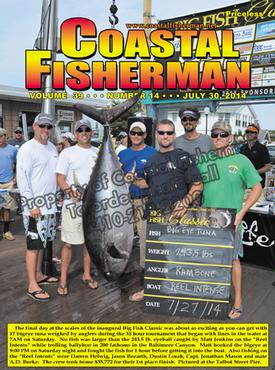


Article by Capt. Mark Sampson
 There’s no doubt that over the last few years, local inshore anglers have fallen head-over-heals in love with the relatively new breed of soft-plastic jigs that not only have a tantalizing action in the water, but are also impregnated with a scent designed to mimic natural prey species, as well as stimulate a fish to feed. A lot of design and testing has gone into many of these lures that has provided products that, by themselves, have the look and action that will solicit bites from many species of fish. But as the manufactures of these lures so adamantly point out, what really puts them over the top of similar soft plastic jig-type lures is the “stink”, because not only do they look and act like a tempting morsel, they smell like it too. Mmmmm, it makes me hungry just thinking about it!
There’s no doubt that over the last few years, local inshore anglers have fallen head-over-heals in love with the relatively new breed of soft-plastic jigs that not only have a tantalizing action in the water, but are also impregnated with a scent designed to mimic natural prey species, as well as stimulate a fish to feed. A lot of design and testing has gone into many of these lures that has provided products that, by themselves, have the look and action that will solicit bites from many species of fish. But as the manufactures of these lures so adamantly point out, what really puts them over the top of similar soft plastic jig-type lures is the “stink”, because not only do they look and act like a tempting morsel, they smell like it too. Mmmmm, it makes me hungry just thinking about it!
Scented jigs are made by a number of manufactures, but the Berkley “Gulp!” brand has, by far, become the most popular and it’s easy to see why – they work! Flip through the pages of the Coastal Fisherman and you’ll see fish after fish caught on Gulp! artificials. These lures have proven themselves so often that many anglers now claim that they can catch more fish with them than they can on natural bait.
The popularity of scented plastics certainly isn’t isolated to Delmarva. They seem to have taken off everywhere there’s water - fresh or salt. While down in the Florida Keys this winter, I noticed that a lot of anglers (myself included) were using them on the flats for redfish and bonefish, as well as over the reefs and in the channels for snapper, grouper and grunts.
Similar to the way it is up here, even down south, the artificials would sometimes outperform natural baits.
One of the greatest advantages of these jigs is that anglers can keep a supply of them on their boat or in their tackle box and always have a good substitute for natural bait, ready in case an unexpected fishing opportunity comes along. Delmarva anglers who almost exclusively troll offshore for marlin and tuna can keep a container of scented jig tails stashed in a tackle cabinet and always be ready just in case they have a notion to stop over a wreck on the way back from the canyons and grab a few sea bass for dinner. That’s a lot better than buying squid or clams in the morning “just in case” and then throwing it away if it’s not used.
As good as the Gulp! type artificials are, they do have one problem – they aren’t exactly cheap compared to most other soft plastic lures, and when anglers are being swamped by toothy fish such as bluefish, an angler can go through a lot of expensive jig tails really quick and suddenly find themselves with a need to run back to the tackle shop for another bucket of tails.
Fortunately there’s a relatively inexpensive alternative to fishing Gulp! type jigs that at times can sometimes catch just as many fish.
Scented jigs solicit bites for three reasons: sight, smell, and the lure’s action. But as we all know, there are a lot of other artificials on the market that don’t work on the smell factor to get a bite, and there are some darn good soft plastics that fall into this category. I’m not dismissing the fact that smell can be an attractant to fish, and sometimes give an otherwise finicky fish one more reason to bite something. But a lot of times, a fish will bite out of reaction to something swimming past, rather than first seeing it, smelling it and then deciding “yea, that looks and smells good enough to eat, I think I’ll give it a try.” A reaction bite might come from a fish that’s just holding somewhere in the water or maybe cruising along when all of a sudden a wiggly, squishy, bouncy thing that kind of looks like food goes shooting past it’s face and the fish knows that if it doesn’t bite quick it won’t get a second chance. It’s the kind of “bite first - ask questions later” way of feeding that most lure fishermen always hope for.
So the moral of the story is that anglers should, by all means, keep a supply of scented soft plastic jig tails on hand to use as either a primary bait for flounder, bluefish, trout, striped bass, redfish or sea bass, or any other inshore species they might be targeting. But it could be a costly mistake to get so hung up on the thought that if it hasn’t been impregnated with some kind of high-tech, secret formula scent-juice that it won’t catch fish, because in a lot of cases it sure will, and it will do it for a lot less cost per/tail, which can translate to a huge savings when anglers find their lures being attacked by schools of hungry bluefish!
Captain Mark Sampson is an outdoor writer and captain of the charter boat “Fish Finder”.